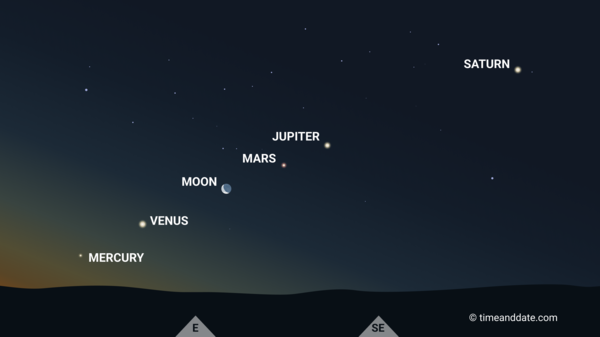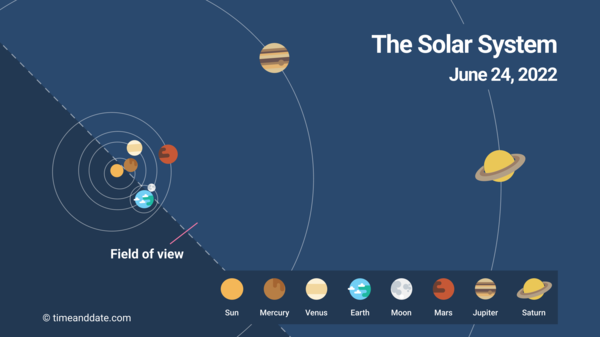Classical Planets to Form Cosmic Queue
The seven wandering classical planets—including the Moon and the Sun—line up in the sky this month. Find out where and when to spot the planetary alignment.

An image from our Night Sky Map shows the view from New York City, USA, at 04:40 local time (4:40 am) on June 24.
©timeanddate.com
The Wanderers Align
The classical planets—the seven astronomical bodies that can be seen without a telescope, and appear to move in relation to the stars—are coming into an eye-catching alignment.
Mercury, Venus, the Moon, Mars, Jupiter, and Saturn will line up in order of their distance from the Sun in the pre-dawn sky from June 23 to 25.
Our graphic at the top of this page shows the view from New York City about 45 minutes before sunrise on June 24.
The seventh classical planet—the Sun itself—makes its presence felt in the form of a reddish glow coming from just beneath the horizon.
The word planet originally comes from an ancient Greek word meaning “wanderer”, to distinguish it from the “fixed” stars. (Some sources include Uranus, Neptune, and Pluto in their definitions of the “classical” planets, although these bodies were not discovered until after the invention of the telescope in the 17th century.)
Night Sky Map: find objects in the sky
Not Actually in a Line
What looks like a near-perfect alignment to us on Earth is an illusion caused by perspective. Seen from space, the celestial bodies do not form a straight line.
Let’s imagine flying up into space, and looking down on the solar system from way above the North Pole. The graphic below shows us what we would see on June 24.

An illustration of the solar system on June 24, looking down from far above the North Pole. Distances from the Sun are to scale, but the sizes of the astronomical bodies are not.
©timeanddate.com
The “field of view” explains the view from New York and other cities in the Northern Hemisphere, shortly before sunrise.
From left to right, the Sun is just outside the field of view, while Mercury is just included. Next comes Venus, the Moon, Mars, and Jupiter. Finally, somewhat separated from the others, there is Saturn.
The View from the Other Side of Earth
Now let’s imagine we fly back down to Earth, but instead of landing in the Northern Hemisphere, we travel to the other side of our planet.
The graphic below shows the view from Sydney, Australia, about 30 minutes before sunrise on June 24. Because this is a view from the Southern Hemisphere, the five planets—together with the Moon, and the glow of the Sun—line up the other way round.

This image from our Night Sky Map shows the view from Sydney, Australia, at 06:30 local time (6:30 am) on June 24.
©timeanddate.com
Start Looking Now
Although the above images are all for June 24, the celestial line-up will be visible in the pre-dawn sky before and after this date.
Night Sky Map: find objects in the sky
The main difference will be the position of the Moon. Of the seven classical planets, the Moon appears to move the quickest in relation to the stars.
The classical planets: Why Monday comes before Tuesday
Visible Worldwide, Almost
The cosmic queue of planets is visible from around the globe. However, for cities farther north than New York—for example, Toronto or London—Mercury becomes difficult or impossible to spot.
In the very far north, where the Sun hardly sets in June—or doesn’t set at all—few or none of the planets can be seen.
The event is also invisible from the South Pole. This part of the globe is in permanent darkness during June, and the planets are mostly hidden beneath the horizon.
Did you know? Our friends at Astronomers Without Borders have voted the June planetary alignment one of their top “Sky Events” for 2022.